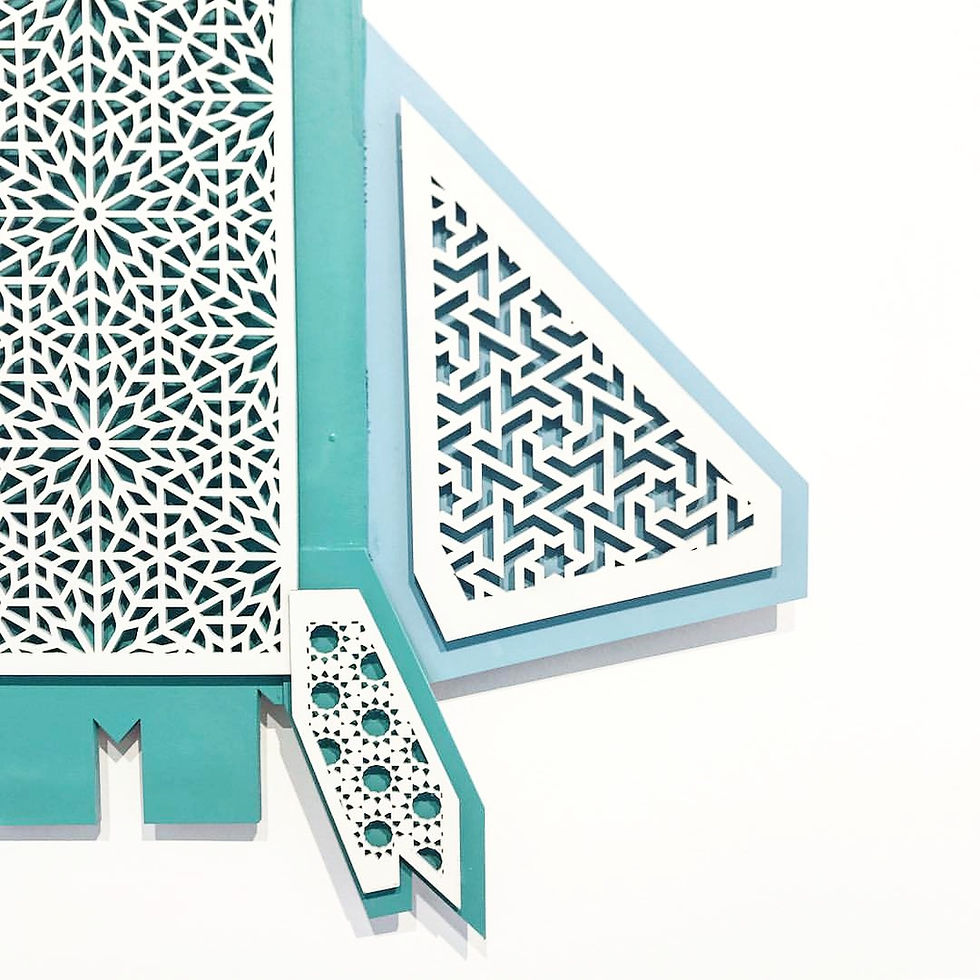The Intersection of Art and Heritage: The Geometric Odyssey of Keyvan Shovir
- Keyvan Shovir
- Jan 15, 2024
- 3 min read

In my artistic pursuits, I've embarked on a profound journey into the world of geometry and its profound presence within the realm of Islamic art. This voyage has been a fusion of my cultural upbringing in Iran, my academic endeavors, and my unending quest to comprehend the intricate interplay between art, geometry, spirituality, and my Persian heritage.
Geometry in Islamic Art: An Echo of the Infinite Islamic art is renowned for its extensive utilization of geometric patterns, a defining characteristic that spans across various cultural traditions from the Middle East to regions as distant as Spain, India, Indonesia, and sub-Saharan Africa. These geometric designs aren't merely superficial embellishments; they possess a deeper, almost cosmic significance. They are perceived as reflections of the boundless nature of a higher power, a concept deeply ingrained in Islamic philosophy and art.

My Roots in Iran: Nurturing Geometric Mastery Growing up in Tehran, the bustling heart of Iran, I was enveloped by the presence of age-old mosques and structures that serve as testaments to the marvels of geometric artistry. The experience of immersing myself in the study of Iranian art history and painting within such an environment kindled my passion for mathematics and the intricate world of geometric patterns. Countless hours were dedicated to exploring these architectural marvels, each endeavoring to unravel the complex interplay of shapes, patterns, and colors that composed their design.

The Hexagonal Pattern: A Portal to Harmony Among the myriad of patterns that captured my attention, the hexagonal pattern held a special place. It was ubiquitous, appearing not only in the buildings and miniatures I scrutinized but also in the patterns found in nature. To me, this hexagonal motif symbolizes harmony and equilibrium, resonating with the interconnectedness that governs the universe. This discovery propelled me into a deeper exploration of geometry's role in art and nature.
Islamic Geometry: Beyond Aesthetic Beauty Islamic geometric patterns often incorporate fundamental shapes such as circles, squares, stars, and intricate polygons. These elementary shapes form intricate designs that transcend mere decorative elements; they serve as expressions of profound philosophical and religious concepts. For instance, the use of geometric patterns in Islamic architecture extends beyond the avoidance of figurative images; it delves into more profound and rational explanations. These patterns were masterfully employed to manipulate spatial transitions within structures, such as domes and arches, evolving and elaborating in successive centuries.
Science and Mathematics in Service of Faith Islamic art and architecture seamlessly converge with science and mathematics, especially in the crafting of astrolabes and the precise determination of the qibla for prayer spaces. The cubic form of the Kaaba, central to the rituals of circumambulation, exemplifies the use of geometry in religious practices. Furthermore, the exalted status of the Arabic language and script in Islamic cultures has contributed to the development of intricate calligraphic forms often rooted in systems of geometric proportion.

Patterns in the Plane: Symmetry and Periodicity The integration of geometric patterns in Islamic edifices can be traced back to the earliest Islamic structures. These patterns showcase a plethora of symmetries and periodicities, frequently incorporating square, rectangular, triangular, and hexagonal grids. In my own creative journey, I strive to capture the essence of this symmetry and periodicity, drawing inspiration from these ancient and enduring designs.
Incorporating Persian Heritage: A Deeper Connection What sets my artistic exploration apart is my deep connection to my Persian heritage. I find immense joy in incorporating the knowledge and artistic traditions of Iran into my work. This is why I'm drawn to geometric art, as it seamlessly integrates with the rich tapestry of Persian art and culture. By infusing my art with elements from my heritage, I aim to bridge the gap between past and present, allowing these timeless geometric patterns to transcend through time and culture.

Conclusion: An Ever-Evolving Expedition into Geometric Art My artistic odyssey is an unceasing exploration of the nexus between geometry, art, spirituality, and my Persian heritage. It represents a sincere endeavor to encapsulate the quintessence of Islamic geometric patterns, which transcend being mere ornamental facets to serve as mirrors reflecting a profound comprehension of the universe.
This perpetual exploration of geometry in Islamic art is a journey that perpetually ignites my imagination and informs my creative work. It stands as a testament to the timeless beauty and intricate complexity of these patterns, which have enthralled artists and mathematicians alike across centuries.




















Comments